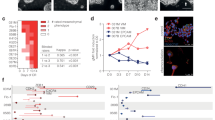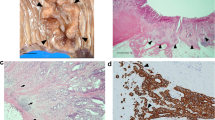Abstract
We have previously observed in vitro that some stromal proteinases (MMP-2, MT1-MMP) were expressed or activated by invasive carcinoma cell lines exhibiting mesenchymal features, presumably acquired through an epithelial to mesenchymal transition (EMT). To examine the potential contribution of c-ets-1 to this phenotype, we have compared here the expression of c-ets-1 with invasiveness in vitro and expression of vimentin, E-cadherin, uPA, MMP-1 and MMP-3 in a panel of human breast cancer cell lines. Our results clearly demonstrate an association between c-ets-1 expression and the invasive, EMT-derived phenotype, which is typified by the expression of vimentin and the lack of E-cadherin. While absent from the two non-invasive, vimentin-negative cell lines, c-ets-1 was abundantly expressed in all the four vimentin-positive lines. However, we could not find a clear quantitative or qualitative relationship between the expression of c-ets-1 and the three proteinases known to be regulated by c-ets-1, except that when they were expressed, it was only in the invasive c-ets-1-positive lines. UPA mRNAs were found in three of the four vimentin-positive lines, MMP-1 in two of the four, and MMP-3 could not be detected in any of the cell lines. Intriguingly, MDA-MB-435 cells, which exhibit the highest metastatic potential of these cell lines in nude mice, expressed vimentin and c-ets-1, but lacked expression of these three proteinases, at least under the culture conditions employed. Taken together, our results show that c-ets-1 expression is associated with an invasive, EMT-derived phenotype in breast cancer cells, although it is apparently not sufficient to ensure the expression of uPA, MMP-1 or MMP-3, in the vimentin-positive cells. Such proteases regulation is undoubtedly qualified by the cellular context. This study therefore advances our understanding of the molecular regulation of invasiveness in EMT-associated carcinoma progression, and suggests that c-ets-1 may contribute to the invasive phenotype in carcinoma cells.
Similar content being viewed by others
References
Stetler-Stevenson WG, Aznavoorian S and Liotta LA, 1993, Tumor cell interactions with the extracellular matrix during invasion and metastasis. Ann Rev Cell Biol, 9, 541–73.
MacDougall JR and Matrisian L, 1995, Contribution of tumor and stromal matrix metalloproteinases to tumor progression, invasion and metastasis. Cancer Metast Rev, 14, 351–62.
MacLeod K, Leprince D and Stehelin D, 1992, The Etsgene family. Trends Biochem Sci, 17, 251–6.
Wasylyk B, Hahn SL and Giovane A, 1993, The Ets family of transcriptional factors. Eur J Biochem, 277, 7–18.
Leprince D, Gegonne A, Coll J, et al.1983, A putative second cell-derived oncogene of the avian leukaemia retrovirus E26. Nature, 306, 395–7.
Nunn MF, Seeburg PH, Moscovici C and Duesberg PH, 1983, Tripartite structure of the avian erythroblastosis virus E26 transforming gene. Nature, 306, 391–5.
Karim FD, Urness LD, Thummel CS, et al.1990, The ETS-domain: a new DNA-binding motif that recognizes a purine-rich core DNA sequence. Gene Dev, 4, 1451–3.
Quinones S, Sans J, Otari Y, Harris EDJ and Kurkinen M, 1989, Transcriptional regulation of human stromelysin. J Biol Chem, 264, 8339–44.
Gutman A and Wasylyk B, 1990, The collagenase gene promoter contains a TPA and oncogene-responsive unit emcompassing the PEA3 and AP-1 binding sites. EMBO J, 9, 2241–6.
Nerlov C, Rorth P, Blasi F and Johnsen M, 1991, Essential AP-1 and PEA3 binding elements in the human urokinase enhancer display cell-type specific activity. Oncogene, 6, 1583–92.
Gaire M, Zenaida M, McDonnell S, McNeil L, Lovett DH and Matrisian LM, 1994, Structure and expression of the human gene for the matrix metalloproteinase matrilysin. J Biol Chem, 269, 2032–40.
Wasylyk C, Gutman A, Nicholson R and Wasylyk B, 1991, The c-Etsoncoprotein activates the stromelysin promoter through the same elements as several nonnuclear oncoproteins. EMBO J, 10, 1127–34.
Higashino F, Yoshida K, Noumi T, Seiki M and Fujinaga K, 1995, Ets-related protein E1A-F can activate three different matrix metalloproteinase gene promoters. Oncogene, 10, 1461–63.
Crawford HC and Matrisian LM, 1996, Mechanisms controlling the transcription of matrix metalloproteinase genes in normal and neoplastic cells. Enzyme and Proteins, 49, 20–37.
Wernert N, Gilles F, Fafeur V, et al.1994, Stromal expression of c-Ets-1 transcription factor correlates with tumor invasion. Cancer Res, 54, 5683–8.
Vandenbunder B, Queva C, Desbiens X, Wernert N and Stehelin D, 1994-95, Expression of the transcription factor c-Ets-1 correlates with the occurrence of invasive processes during normal and pathological development. Invasion & Metastasis, 14, 198–209.
Bolon I, Brambilla E, Vandenbunder B, Robert C, Lantuejoul S and Brambilla C, 1996, Changes in the expression of matrix proteases and of the transcription factor c-Ets-1 during progression of precancerous bronchila lesions. Lab Invest, 75, 1–13.
Wernert N, Raes MB, Lasalle P, et al. 1992, c-Ets-1 proto-oncogene is a transcription factor expressed in endothelial cells during tumor vascularization and other forms of angiogenesis in humans. Am J Pathol, 140, 119–27.
Bolon I, Gouyer V, Devouassoux M, et al.1995, Expression of c-Ets-1, collagenase 1, and urokinasetype plasminogen activator genes in human lung carcinomas. Am J Pathol, 147, 1298–309.
Polette M and Birembaut P, 1996, Matrix metalloproteinases in breast carcinoma. The Breast Journal, 2, 209–20.
Gilles C and Thompson EW, 1996, The epithelial to mesenchymal transition and metastatic progression in carcinoma. The Breast Journal, 2, 83–96.
Savagner P, Boyer B, Valles AM, Jouanneau J and Thiery JP, 1994, Modulations of the epithelial phenotype during embryogenesis and cancer progression. In: Dickson R and Lippman M, eds. Mammary Tumorigenesis and Malignant Progression .Kluwer Academic Publishers, Chapter 12, pp. 229–49.
Guarino M, 1995, Epithelial-to-mesenchymal change of differentiation. From embryogenetic mechanism to pathological patterns. Histol Histopathol, 10, 171–84.
Hay ED, 1995, An overview of epithelio-mesenchymal transformation. Acta Anat, 154, 8–20.
Sommers CL, Thompson EW, Torri JA, Kemler EP, Gelmann EP and Byers SW, 1991, Cell adhesion molecule uvomorulin expression in human breast cancer cell lines: relationship to morphology and invasive capacities. Cell Growth and Differentiation, 2, 365–72.
Thompson EW, Paik S, Brünner N, </del>et al.1992, Association of increased basement membrane invasiveness with absence of estrogen receptor and expression of vimentin in human breast cancer cell lines. J Cell Physiol, 150, 534–44.
Azzam HS and Thompson EW, 1992, Collageninduced activation of the Mr 72,000 type IV collagenase in normal and malignant human fibroblastoid cells. Cancer Res, 52, 4540–4.
Azzam H, Arrand GA, Lippman ME and Thompson EW, 1993, MMP-2 activation potential associates with metastatic progression in human breast cancer cell lines, and is independent of MMP-2 production. J Natl Cancer Inst, 85, 1758–64.
Bae SN, Arand G, Azzam H, et al. 1993, Molecularand cellular analysis of basement membrane invasionby human breast cancer cells in Matrigel-based in vitroassays. Breast Cancer Res and Treat, 24, 241–55.
Gilles C, Polette M, Piette J, Birembaut P and FoidartJM, 1994, Epithelial to mesenchymal transition inHPV-33-transfected cervical keratinocytes is associatedwith increased invasiveness and expression ofgelatinase A. Int J Cancer, 59, 661–6.
Sommers CL, Byers SW, Thompson EW, Torri J and Gelmann EP, 1994, Differentiation state and invasiveness of human breast cancer cell lines. Breast Cancer Res Treat, 31, 325–35.
Gilles C, Polette M, Piette J, et al.1996, High level of MT-MMP expression is associated with invasiveness of cervical cancer cells. Int J Cancer, 65, 209–13.
Gilles C, Polette M, Piette J, Thompson EW, Foidart JM and Birembaut P, 1996, Vimentin expression in cervical carcinomas: association with the invasive and the migratory phenotype of tumor cells. J Pathol, 180, 175–80.
Pulyaeva H, Bueno J, Polette M, et al.1997, MT1-MMP correlates with MMP-2 activation potential seen after epithelial to mesenchymal transition in human breast carcinoma cells. Clin Exp Metastasis, 15, 111–20.
Gilles C, Polette M, Seiki M, Birembaut P and Thompson EW, Collagen type I-induced MT1-MMP expression and MMP-2 activation: implication in the metastatic progression of breast carcinoma. Lab Invest, in press.
Thompson EW, Nakamura S, Shima TB, et al.1991, Supernatants of acquired immunodeficiency syndrome-related Kaposi's sarcoma cells induce endothelial cell chemotaxis and invasiveness. Cancer Res, 51, 2670–76.
Schuh R, Vestweber D, Riede I, et al.1986, Molecular cloning of the mouse cell adhesion molecule uvomorulin: cDNA contains a B1-related sequence. Proc Natl Acad Sci USA, 83, 1364–68.
Sommers C, Walker-Jones D, Heckford SE, et al. 1989, Vimentin rather than keratin expression in some hormone-independent breast cancer cell lines and in oncogene-transformed mammary epithelial cells. Cancer Res, 49, 4258–63.
Rømer J, Pyke C, Lund LR, et al. 1994, Expression of uPA and its receptor by both neoplastic and stromal cells during xenografts invasion. Int J Cancer, 57, 553–60.
Goldberg GI, Wilhem SM, Kronberger A, Bauer EA, Grant GA and Eisen AZ, 1986, Human fibroblast collagenase. Complete primary structure and homology to an oncogene transformation-induced rat protein. J Biol Chem, 261, 6600–5.
Wilhelm SM, Collier IE, Kronberger A, et al.1987, Human skin fibroblast stromelysin: structure, glycolylation, substrate specificity, and differential expression in normal and tumorigenic cells. Proc Natl Acad Sci USA, 84, 6725–9.
Holst-Hansen C, Johannessen B, Høyer-Hansen G, Rømer J, Ellis V and Brünner N, 1996, Urokinasetype plasminogen activation in three human breast cancer cell lines correlates with their in vitroinvasiveness. Clin Exp Metastasis, 14, 297–307.
Price JE, Polyzos A, Zhang RD and Daniels LM, 1990, Tumorigenicity and metastasis of human breast carcinoma cell lines in nude mice. Cancer Res, 50, 717–21.
Brünner N, Thompson EW, Spang-Thomsen M, Rygaard J, Danø K and Zwiebel JA, 1992, LacZ transduced human breast cancer xenografts as an in vivo model for the study of invasion and metastasis. Eur J Cancer, 28, 1989–95.
Frandsen TL, Boysen BE, Jirus S, et al.1992, Assays for the study of human cancer cell invasion and metastasis. Fibrinolysis, 6, 71–6.
Borchers AH, Powell MB, Fusenig NE and Bowden T, 1994, Paracrine factor and cell-cell contact-mediated induction of protease and c-Etsgene expression in malignant keratinocyte/dermal fibroblast cocultures. Exp Cell Res, 213, 143–7.
Gilles F, Raes MB, Stehelin D, Vandenbunder B and Fafeur V, 1996, The c-Ets-1 proto-oncogene is a new early-response gene differentially regulated by cytokines and growth factors in human fibroblasts. Exp Cell Res, 222, 370–8.
Calmels TPG, Mattot V, Wernert N, Vandenbunder B and Stehelin D, 1995, Invasive tumors induce c-Ets-1 transcription factor expression in adjacent stroma. Biol Cell, 84, 53–61.
Chen JH, Vercamer C, Li Z, Paulin D, Vandenbunder B and Stehelin D, 1996, PEA3 transactivates vimentin promoter in mammary epithelial and tumor cells. Oncogene, 13, 1667–75.
Brünner N, Pyke C, Holst Hansen C, Rømer J, Grøndhal-Hansen J and Danø K, 1994, Urokinase plasminogen activator (uPA) and its type 1 inhibitor (PAI-1): regulators of the proteolysis during cancer invasion and prognostic parameters in breast cancer. In: Dickson R and Lippman M, eds. Mammary Tumorigenesis and Malignant Progression .Kluwer Academic Publishers, Chapter 16, pp. 299–309.
Basset P, Bellocq JP, Wolf C, et al.1990, A novel metalloproteinase gene specifically expressed in stromal cells of breast carcinomas. Nature, 348, 699–704.
Polette M, Clavel C, Cockett M, Girod de Bentzmann S, Murphy G and Birembaut P, 1993, Detection and localization of mRNAs encoding matrix metalloproteinases and their tissue inhibitor in human breast pathology. Invasion Metast, 13, 31–7.
Okada A, Bellocq JP, Rouyer N, et al.1995, Membrane-type matrix metalloproteinase (MT-MMP) gene is expressed in stromal cells of human colon, breast, and head and neck carcinomas. Proc Natl Acad Sci USA, 92, 730–4.
Kaya M, Yoshida K, Higasahino F, Mitaka T, Ishii S and Fujinaga K, 1996, A single Ets-related transcription factor, E1AF, confers invasive phenotype on human cancer cells. Oncogene, 12, 221–7.
Wasylyk B, Wasylyk C, Flores P, Begue A, Leprince D and Stehelin D, 1990, The c-Etsproto-oncogene encodes transcription factor that cooperate with c-Fos and c-Jun for transcriptional activation. Nature, 346, 191–3.
Logan SK, Garabedian MJ, Campbell CE and Werb Z, 1996, Synergistic transcriptional activation of the tissue inhibitor of metalloproteinases-1 promoter via functional interaction of AP-1 and Ets-1 transcription factors. J Biol Chem, 271, 774–82.
Author information
Authors and Affiliations
Rights and permissions
About this article
Cite this article
Gilles, C., Polette, M., Birembaut, P. et al. Expression of c-ets-1 mRNA is associated with an invasive, EMT-derived phenotype in breast carcinoma cell lines. Clin Exp Metastasis 15, 519–526 (1997). https://doi.org/10.1023/A:1018427027270
Issue Date:
DOI: https://doi.org/10.1023/A:1018427027270




